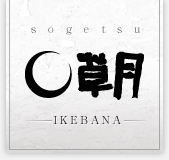
The flower becomes me.
Philosophy
Flowers and plants are beautiful as they are. But with people’s help, they can be arranged in an effective style to be even more appreciated. A Japanese theory of flower arranging has philosophy which brightens, colors, and gives life to our environment. Ikebana can be done by anyone, anywhere, with almost anything. Sogestu arrangements vary with the change of surroundings and can incorporarte fresh as well as dried, bleached, painted and unconventional materials. Sogetsu School of ikebana believes that anyone can arrange ikebana anywhere, and with almost anything. It should be part of a lifestyle to be appreciated by many people from all over the world, rather than being considered an exclusive aspect of Japanese culture to be enjoyed by a limited number of people. Just as people are different from each other, Sogetsu School encourages ikebana students to be individual and imaginative and aim for a contemporary effect that is refreshing and attractive.The basic techniques are taught by instructors with the use of textbooks all over the world.
History
Sofu Teshigahara, First Iemoto 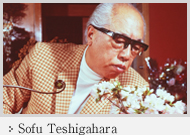
Prior to 1927, the practice of ikebana followed and recreated established forms. Sofu Teshigahara, the late (1900-1979) first son of Wafu Teshigahara, an ikebana artist, broke away from his father and founded the Sogetsu School of Ikebana. Through the school he developed his practice of teaching creative ikebana that reflects the modern age. His primary premise for the Sogetsu School, Anyone can enjoy and create Sogetsu Ikebana anytime, anywhere, using any material, was a revolutionary concept.
After his first exhibition in 1929 at Sembikiya in the Ginza was so well received he became the instructor of Ikebana on NHK radio. Through the broadcasts and subsequent exhibitions, the late Iemoto (headmaster), made sogestu widely known.
In 1930, Iemoto Sofu Teshigahara contributed to a “Manifesto of New Ikebana”, a reflection of the avant-garde modern art movement in Europe. It proclaimed ikebana as one of the contemporary fine arts, rejecting fixed forms. Time magazine declared him as the “Picasso of Flowers” as he exhibited around the world. He formed live-long friendships with the artists Salvador Dali, Antoni Gaudi, Joan Miro and Antoni Tapies.
Despite the sparse ikebana activities were sparse during World War II, he opened”Sofu Teshigahara and Houn Ohara, Two-Man Exhibition” in 1946 and resumed activity post-war. He continued to exhibit and conduct demonstrations around Europe and the United Stated between 1950 and 1970. Accolades include the Oder of Arts and Letters (1960) and The Legion of Honor (1961) from France, and the Minister of Education Awards for Art (1962) from Japan. In 1955, Time magazine described him as the “Picasso of Flowers.”
He continued to express his creativity though ikebana, sculpture and calligraphy until his death. To celebrate the centennial anniversary of his birth, a retrospective of his works was exhibited at the Setagaya Art Museum in Tokyo in 2001.
Kasumi Teshigahara, Second Iemoto
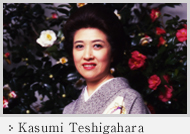
After Sofu’s death, his daughter Kasumi Teshigahara (1932-1980) became the second Iemoto. Studying and practicing under her father, her illustrious career began in 1951 with her first solo exhibition. She and a group of colleagues established the Kasumi Group and expanded the prospects of Ikebana to include broadcasting Ikebana lessons on the radio and stage designs for chanson singer Yoshiko Ishii. Kasumi specialities included miniatures and arrangements incorporating dried or colored materials. She passed away shortly being being designated as the second Iemoto and was succeeded by Hiroshi Teshigahara.
Hiroshi Teshigahara, Third Iemoto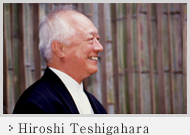
Hiroshi (1927-2001), the first son of Sofu Teshigahara, a well respected film and opera stage director was known for his breathtaking bamboo installations. His bamboo installations received international acclaim in Korea, Italy and the United States. He produced exhibitions and installations in Japan and also presented tea ceremonies in countries all over the world. Additionally, Hiroshi was an acclaimed ceramic artist and calligrapher. He supported Renka, a series of improvised Ikebana arrangements created by multiple artists in the 1990’s. When he died in the spring of 2001, he was succeeded by his daughter, Akane Teshigahara.
Akane Teshigahara, Current Iemoto
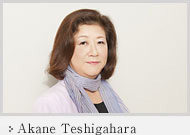
Born in 1960, Akane Teshigahara the second daughter of Hiroshi Teshigahara studied Ikebana under her aunt, Kasumi Teshigahara. ready
her father, she is a powerful installation artist who believes that ikebana must be assimilated in aspects of our contemporary lives. She has promoted the Sogetsu School to wider audiences by bringing ikebana to a theater. “Iemoto Ikebana Live“, the theatrical presentation of flower arrangement that incorporates sound and lighting effects, has been performed around the world as well as in Japan. She instituted “Akane Junior Class“ to teach children to developartistic awareness by interacting and composing flowers and plants.
The Sogetsu Plaza was designed by a world-famous artist, Isamu Noguchi. The plaza, a rock garden titled Ò Tengoku Ó (heaven) is a sculpture work of Today, this plaza is used for the construction of works for the Sogetsu Summer Seminars and the exhibitions of Sogetsu artists.
2-21, Akasaka 7-chome,
Minato-ku, Tokyo 107-8505
TEL:03-3408-1154
FAX:03-3405-4947
